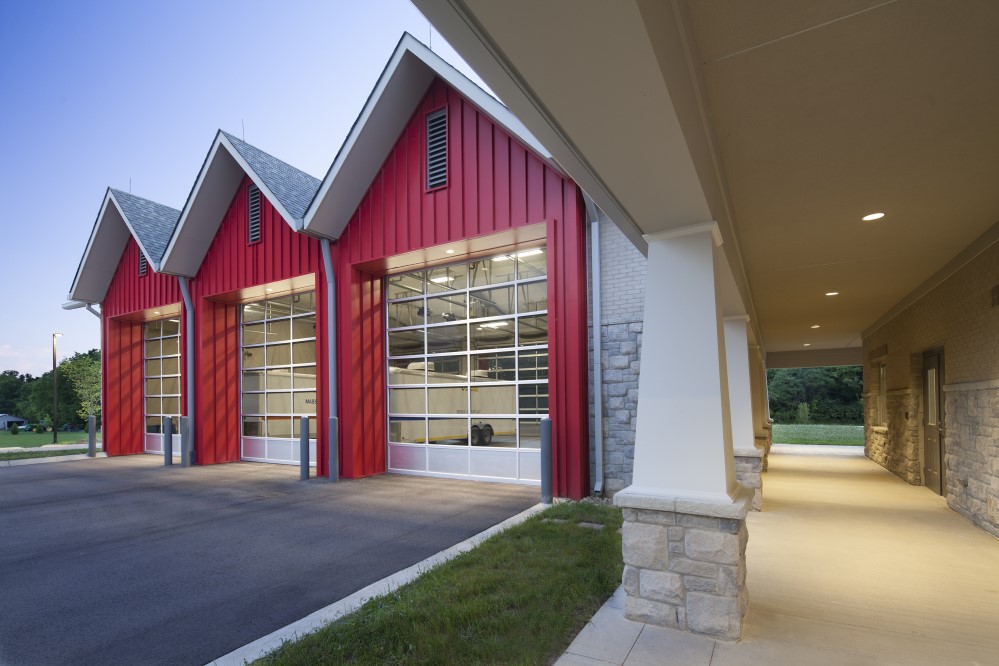
Public safety is likely one of the highest priorities for all civic leaders. Essential services like police, fire, rescue, and 911 dispatch are often taxpayer-funded and serve their communities 24 hours a day, 365 days a year.
Each small, medium, and large municipality and unincorporated area has unique needs for which first responders are trained and respond to regularly. But what about those needs that are out of the norm—those surprise events that only happen once in five, 10, or 50 years? That is when communities need essential services the most.
Consider everything a first responder requires to effectively do their job: vehicles, uniforms, protective gear, recovery tools, firearms, ammunition, rescue equipment, breathing apparatus, computers, radios, medicine, etc. All these critical, life-saving items are likely stored indoors. And so are the most important assets of all—the first responders themselves. So how effective can a department be if their own facility has been compromised? All the investment, training, and readiness may be severely diminished if the essential buildings are not accessible or operational before, during, and after a tragic event.
Designing resilient public safety facilities requires consideration of a wide array of factors that can influence survivability of people, infrastructure, and equipment against the most probable threats for a specific location. Basic building codes require all buildings to meet minimum design criteria to protect the health, safety, and welfare of the occupants, and are updated regularly to maintain relevance with fundamental trends and technologies. However, most public safety buildings fall into Risk Category IV of the commonly adopted building code—the International Building Code (IBC). This means that police, fire, and rescue stations, as well as emergency communication facilities, are held to more stringent design criteria than other building types.
IBC Risk Category IV specifically addresses threats from naturally occurring events such as wind, snow, floods, and earthquakes. It does not guarantee that a facility will maintain operation or even survive all potential weather-related threats, but the requirements for system redundancies and a more robust structural design increases the odds of survivability compared to other building types. These requirements can be considered the basic level of building “hardening.”
There are many other design guidelines and strategies for increased chances of facility and emergency infrastructure survivability. Many federal buildings are required by the General Services Administration to comply with Department of Defense, FEMA, and similar requirements to mitigate against a multitude of threats, including weather, accidental, and criminal events. However, most state and local governments do not have mandated design or survivability criteria to protect their buildings, assets, and ability to respond beyond the minimum requirements of locally adopted codes.
Increased hardening of a facility does not have to mean a more expensive facility. Certainly, if increased resilience to natural events such as hurricanes and tornadoes is desired, the structure and building envelope will almost certainly be more expensive than a code-minimum design. But not all hardening concepts will increase the cost of the building.
Principles associated with “crime prevention through environmental design” (CPTED) can influence a variety of design decisions from the positioning of the building on the property to the types of plants specified on site. For example, “standoff” distance typically refers to how close an unscreened vehicle can get to the nearest exterior wall of the building. Providing a natural barrier, such as a berm or swale at a building entrance, not only prevents potential criminal activity, but also prevents accidental vehicle incidents.
The value of a facility designed to remain accessible and operational before, during, and after an event is immeasurable. The analogy of a flight attendant instructing passengers to first apply the mask to themselves so that they may assist others during an emergency can be applied to a municipality’s public safety building network and infrastructure. It is incumbent upon civic leadership to prioritize operational and capital funding to ensure first responders have adequate facilities and resources available to them during their community’s greatest time of need.
Securing funding for a new essential building is often years in the making. Unless a city or county is seeing accelerated population growth or aging facilities, the need to build a new police, fire, or communications facility may not come along often. When it does, it is important to consult a design team experienced in public safety facility design prior to determining the project budget and scope so that current and future needs of the community align with the expected design, construction, and operational costs.
The equipment and infrastructure that first responders depend on inherently and proportionately impact their ability to serve and protect. The facilities from which they are staged, trained, and respond are the first line of defense in a resilient community.
TMPartners (TMP): For nearly 45 years, people have been at the center of everything we do. A nationally recognized firm for design excellence, TMP has a dedicated planning and design team that focus on civic and public safety community-driven projects. The spaces and partnerships we create elevate experiences, where lives are changed and communities flourish. Design starts by knowing what matters most and advancing confidently together. (www.tmpartners.com)

JEFF EARWOOD, AIA, LEED AP, is a civic/public safety practice leader and principal at TMPartners. Jeff has served clients in the public sector his entire career. For nearly two decades, he has led TMP teams in the design of public safety projects, including police, fire, rescue, 911 dispatch, and emergency management. Through his experience with a variety of essential services departments and municipalities, Jeff has a unique ability to connect to stakeholders and engage users in the design process, bringing a high-level of institutional knowledge on best practices in public safety design.
New, Reduced Membership Dues
A new, reduced dues rate is available for CAOs/ACAOs, along with additional discounts for those in smaller communities, has been implemented. Learn more and be sure to join or renew today!
